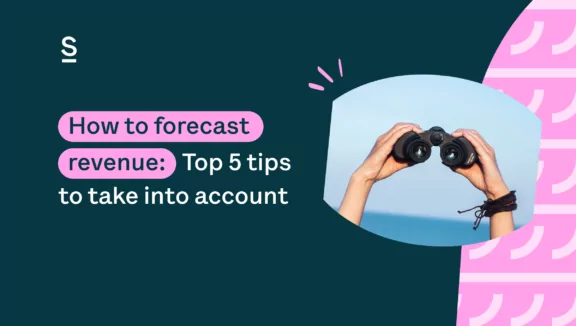How to forecast revenue: Top 5 tips for success

Revenue forecasting is not just a number-crunching exercise—it is a strategic tool that helps businesses map out their future. It provides crucial insights for making informed business decisions, managing cash flow, and preparing for the future. Dive deep with us into the realm of revenue forecasting, discussing how it can be done using Excel, learning tips specifically for startups, and sharing the top tips on how to forecast revenue to ensure your business’s successful revenue growth.
Understanding revenue forecasting: An in-depth study
Knowing how to forecast revenue is a fundamental pillar of any business strategy. It is the process of estimating the amount of revenue that will be generated in future periods, typically the next quarter, year, or sometimes even further out. This prediction is not a shot in the dark but rather a data-driven estimation that leverages historical sales data, market trends, economic indicators, and business insights. A nuanced understanding of revenue forecasting is critical to plan, strategize, and navigate the future course of business effectively.
When delving deeper into how to forecast revenue, it’s crucial to understand its significance. Revenue forecasting drives many strategic decisions within a company. It informs budget allocation, planning for operational costs, determining sales goals, setting prices, and gauging the financial health of the business. It also feeds into other forecasts, such as cash flow and profit forecasts. In short, an accurate revenue forecast provides a roadmap to business growth, enabling leaders to make informed decisions.
A crucial aspect of revenue forecasting is selecting an appropriate method. The choice of method depends on the complexity of your business, the nature of your revenue streams, the availability and quality of data, and the specific purpose of the forecast. Here are three commonly used revenue forecasting methods:
- Historical forecasting.
This method uses historical revenue data as the basis for future predictions, assuming that past patterns will continue into the future. It is a simple and straightforward approach often used by stable and mature businesses with predictable revenue streams. - Market testing
Used often by startups or companies launching new products, this method involves testing the product or service in a small segment of the market to gauge potential sales and extrapolating that to forecast revenue. - Sales funnel-based forecasting
This approach leverages data from the company’s sales pipeline. Each sales opportunity is assigned a probability of closing based on its stage in the sales funnel. These probabilities are used to forecast revenue.
While these methods are useful, it’s important to consider their limitations. For example, historical forecasting may not account for new market trends or changes in the business model. Market testing could be skewed if the test segment is not representative of the larger market. Sales funnel-based forecasting can be over-optimistic if the probabilities of closing are overestimated.
Knowing how to forecast revenue also hinges on understanding the factors that impact your revenue. These can be both internal factors (like sales efforts, marketing campaigns, price changes, or product development) and external factors (like market trends, consumer behavior, economic climate, or competitive actions). A deep understanding of these factors allows you to make adjustments to your forecast model, thus improving its accuracy. They can also include understanding your sales efficiency metrics.
Another key aspect of how to forecast revenue is its periodic review and adjustment. As new actual data comes in, it’s important to revise your forecasts in light of this data. This process, known as ‘rolling forecasts’, allows businesses to stay agile and responsive to changes in the market or business environment.
As we delve into how to forecast revenue, we should consider the challenges it poses. Foremost is the uncertainty of future events. The unpredictability of market conditions, customer behavior, or economic factors can introduce errors into your forecasts. This is where risk analysis and scenario planning come in. By forecasting under different scenarios, you can prepare for a range of outcomes and mitigate risks.
Another challenge is the quality of data. Inaccurate, incomplete, or outdated data can lead to misleading forecasts. Thus, it’s essential to invest in good data management practices, ensuring data is accurate, timely, and relevant.
So, again, understanding how to forecast revenue is not just about crunching numbers—it’s about comprehending the underlying business dynamics, choosing the right forecasting method, considering the influencing factors, dealing with uncertainties, and continuously refining the forecasts as new data emerges. By mastering these elements, you can harness the full potential of revenue forecasting to steer your business towards success. With that said, there are some numbers involved. So here we go:
How to forecast revenue in Excel
Excel, a cornerstone tool in many business operations, proves itself to be versatile and effective when it comes to revenue forecasting. If you’ve been working with numbers and haven’t delved into Excel’s forecasting capabilities, now is a perfect time to explore this dynamic function. In this in-depth guide, we’ll walk you through the process of forecasting revenue in Excel step by step, taking your Excel proficiency to the next level.
To begin with, let’s understand the core of Excel’s revenue forecasting—historical sales data. Historical data is a treasure trove of insights as it reflects your business’s past performance and the impact of various factors on your sales. The more historical data you have, the more reliable your forecast will be. That said, make sure the data is reliable, precise, and accurate and you’ll be ready for how to forecast revenue.
Next, import your data into Excel. Organize it chronologically—this is crucial as Excel’s forecasting function operates on the assumption that the data points are equidistant in time. Creating a timeline in Excel can help visualize this data effectively.
Once your data is imported and organized, you’re ready to make use of Excel’s FORECAST function. This function allows you to predict a future value based on existing values. Excel uses the method of least squares to find the best-fit line for your data and then applies this line to forecast the future values.
To use the FORECAST function, you’ll need a pair of variables—an array of known_y’s (historical sales data) and an array of known_x’s (the corresponding periods). The syntax is FORECAST(x, known_y’s, known_x’s). The ‘x’ in the function is the point in time you want the forecast for.
For instance, if you have sales data for the last 12 quarters and you want to predict the sales for the next quarter, your known_y’s would be your sales figures, your known_x’s would be the period (1-12), and ‘x’ would be 13.
Keep in mind, the FORECAST function in Excel generates a linear forecast, assuming that the trend is linear, i.e., consistently increasing or decreasing. However, sales data often exhibits seasonal trends or fluctuations. If that’s the case for your business, you might want to consider using Excel’s ETS (Exponential Triple Smoothing) function that accounts for seasonality, trends, and random fluctuations.
As you work with Excel’s FORECAST function, be cautious about the pitfalls. Remember that Excel merely follows the instructions given. If your data is not cleaned, has gaps, or inaccuracies, Excel won’t correct it. Instead, these errors will be reflected in your forecast, leading to misleading results.
One common pitfall in the learning curve of how to forecast revenue is relying on a small amount of data or data from a short period. This might result in skewed predictions that don’t truly represent the business’s likely revenue. A limited dataset might miss out on capturing seasonal fluctuations or longer-term trends in the business’s revenue.
It’s also critical to consider the limitations of the Excel forecast. For instance, it might not fully account for external factors such as changes in the market, introduction of new competitors, changes in government regulations, and other non-quantifiable factors that could impact your future revenue.
Furthermore, while Excel’s FORECAST function is a great place to start, it doesn’t necessarily encompass all the nuances that might be inherent to your specific business or industry. For instance, it assumes a linear relationship between the input and output variables, which might not always be the case.
To elevate your skills on how to forecast revenue in Excel, consider leveraging Excel’s built-in data analysis tools. ‘Data Analysis ToolPak’ is a powerful Excel add-on that offers more sophisticated regression and forecasting tools. It can be beneficial when your data is more complex, and linear forecasting may not suffice.
Another way to enhance your Excel forecasting skills is by learning to create forecast charts. These visual representations of your forecasts make the trends and patterns more apparent, making it easier to understand and communicate your forecasts.
In conclusion, Excel is a powerful tool for revenue forecasting if used correctly. It’s flexible, customizable, and with a bit of practice, user-friendly. As you get comfortable with the basic functions, consider exploring its more advanced capabilities to fine-tune your forecasts further. Excel’s forecasting capabilities, combined with an understanding of your business and market, can help you create robust and reliable revenue forecasts. Remember, forecasting isn’t about getting the future numbers spot-on—it’s about setting realistic expectations, preparing for different scenarios, and guiding your business strategy with data-driven insights.
How to forecast revenue for startups
Revenue forecasting for startups can be particularly challenging due to the lack of historical data and the uncertainty that often surrounds early-stage businesses. However, it’s an essential exercise that can help attract investors and guide strategic decision-making.
Startups can use a variety of methods to forecast revenue. These include market research to estimate the total addressable market and the startup’s potential market share, sales pipelines to forecast based on the likely conversion of leads to customers, and financial modeling to incorporate expenses and growth rates into the revenue forecast.
Consider a successful startup that used these forecasting methods. They conducted extensive market research to understand their potential customer base, used a detailed sales pipeline to track potential sales, and regularly updated their financial model to incorporate real-world data and adjust their forecast accordingly.
Strategies for forecasting revenue growth
Revenue, how to forecast revenue, and revenue growth are not the same thing. While revenue refers to the total income generated by a business, revenue growth shows how this income increases over time. Understanding this distinction is crucial when you’re forecasting revenue growth.
Several strategies can help businesses accurately forecast revenue growth. These include using a sales pipeline, which involves forecasting based on your sales process’s conversion rates; market modeling, where you predict revenue based on your total addressable market and expected market share; and historical trend analysis, where past revenue growth rates are used to predict future growth.
When forecasting revenue growth, it’s important to avoid some common mistakes, such as being overly optimistic or failing to consider market and economic trends. These mistakes can lead to inaccurate forecasts and may negatively impact strategic decisions.
Five key tips for successful revenue forecasting
- Leverage historical data
Past performance can often provide insights into future outcomes. Analyzing historical data can help identify trends and patterns that can inform your revenue forecast. - Understand your sales cycle
The length and nature of your sales cycle can significantly impact your revenue. A solid understanding of your sales cycle will enable more accurate forecasting. - Consider market conditions
External factors, such as economic conditions and market trends, can influence your revenue. Incorporating these into your revenue forecast can improve its accuracy. - Regularly update your forecast
Business conditions change, and so should your forecasts. Regularly updating your forecast will ensure it remains relevant and accurate. - Use the right tools
Leveraging the right tools, like Excel or specialized forecasting software, can simplify the process and increase the accuracy of your revenue forecast.
Revenue forecasting is an invaluable tool for businesses of all sizes and industries. By understanding the basics, leveraging Excel for forecasting, considering the unique challenges faced by startups, and implementing top strategies and tips, businesses can create accurate and effective revenue forecasts to guide their future decision-making.
Revenue forecasting FAQs
How to revise revenue forecasts?
Revenue forecasts should not be static; they should evolve with your business. As you receive new data or as market conditions change, it’s important to revise your forecasts. Regularly reviewing and adjusting your forecast can help you stay on top of changes and ensure your forecasts remain relevant and accurate. It can also be useful to see how your forecasts evolve over time. Do they become more or less optimistic? Why? And what can you learn from this?
How often should you revise revenue forecasts?
The frequency with which you revise your revenue forecasts can depend on your specific business circumstances. However, as a general rule, it’s a good idea to revisit your forecasts at least quarterly. More frequent revisions may be necessary if there are significant changes in your business or the market.
How accurate are revenue forecasts typically?
The accuracy of a revenue forecast can vary widely depending on several factors, including the forecasting method used, the quality of the data, and the inherent unpredictability of the market. However, even if a forecast is not 100% accurate, it is still a valuable tool for planning and decision-making.
How can a company improve the accuracy of its revenue forecasts?
There are several strategies a company can use to improve the accuracy of its revenue forecasts. These include using high-quality, up-to-date data; leveraging the right forecasting methods and tools; considering both internal and external factors; and regularly revising and updating the forecast.
Knowing how to forecast revenue, businesses can confidently navigate their path to success, making informed decisions that drive growth and profitability. Remember, forecasting is not about predicting the future with certainty—it’s about making the best possible estimate with the information available. With the right approach and tools, you can create a revenue forecast that is a valuable tool for your business planning.

Power up your sales with Surfe
Connect your CRM to LinkedIn in 60 seconds.
Save time and increase data accuracy immediately.


